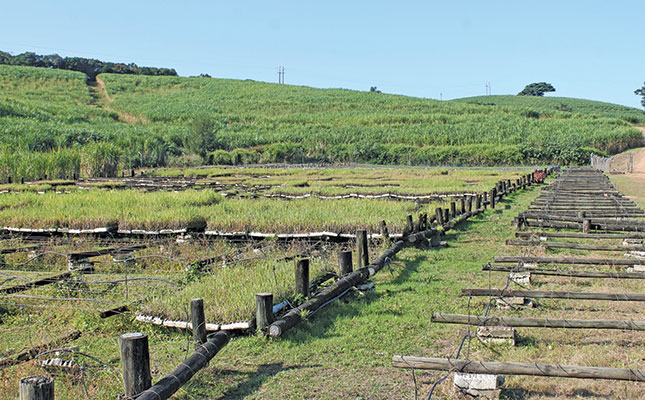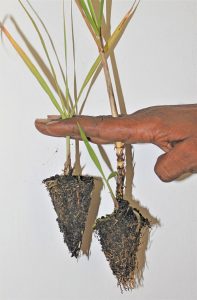Sugar cane speedlings: the fast-track solution to quality seed cane
Conventional stick seed cane, while long relied on as the source of plant material for commercial sugar cane crops, comes with unavoidable inefficiencies. Experts in seed cane propagation explain how the ‘speedlings’ concept provides an alternative, cost-efficient option that has already proven itself in South Africa’s demanding sugar cane farming industry.

Situated barely a stone’s throw from the waves of the warm Indian Ocean, Illovo Sugar’s Sezela Sugar Mill on KwaZulu- Natal’s South Coast crushes about two million tons of sugar cane annually for processing into sugar and other products.
The cane is supplied by growers at all scales of production within the mill’s supply area. As with all of South Africa’s sugar cane farmers, each Sezela mill supplier is paid on the recoverable value (RV) percentage of the cane he or she delivers to the mill.
Writing in the Shukela Plus industry magazine, Dr Muhammad Kadwa, industrial affairs manager of the South African Cane Growers’ Association (SA Canegrowers), explains that the RV payment system incentivises growers to maximise their crops’ sucrose content and minimise its non-sucrose and fibre content to produce better-quality cane.
A crucial aspect of the best management practices required by South Africa’s sugar cane farmers to maximise the RV percentages of their crop is having enough seed cane of the best possible quality. This cane is planted to replace commercial ratoon sugar cane fields whose biomass and RV yields are no longer cost-effective.
According to the South African Sugarcane Research Institute (SASRI), planting good- quality seed cane propagated from cane varieties developed by SASRI for the country’s various production environments is critical for profitable sugar cane production.
The institute’s literature adds that, before seed cane is propagated and planted as a commercial sugar cane crop, it should receive hot water treatment (HWT) against the economically important plant pathogen, ratoon stunting disease (Leifsonia xyli xyli).
Seed cane should also be free of other diseases, such as sugar cane smut (Sporisorium scitamineum), sugar cane mosaic virus (Potyvirus spp) and the African sugar-cane borer (Eldana saccharina). SASRI provides a certification service to assure sugar cane growers that they can buy and propagate disease-free seed cane.
HWT involves submerging the seed cane in 50˚C water for two hours, explains Roland Bridgmohan, manager of Sezela Transplant Nursery, which is owned and operated by the local Sezela Cane Growers’ Association (SCGA).
Sugar cane growers can buy HWT-certified seed cane from third parties or, if they have the necessary facilities on-farm, carry out the treatment themselves.
“Being a grass species, sugar cane is prolific. The sticks of HWT seed cane can be propagated on-farm until there’s enough to be planted as replacements for less productive commercial ratoon fields, which are killed off with herbicide and then ploughed out,” says Bridgmohan.
He adds that while this method of propagating HWT seed cane has many merits, it also has its pitfalls and inefficiencies. For example, harvesting and transporting whole seed cane sticks for HWT, and then conveying them to other fields for propagation and commercial planting, requires bulk haulage and handling facilities that can be expensive to purchase and operate.
Moreover, if the HWT process is not monitored carefully to ensure precise temperature control, poor in-field germination will result.
Enter the speedling
The concept of speeding up the process of propagating plants in seedling trays from parent genetic material is not new to commercial crop production. But using the process to produce sugar cane ‘speedlings’ is still not widely practised in South Africa.
Yet speedlings are a far more efficient way of propagating certified seed cane than the use of whole sticks, especially considering the small areas required, says William Gillham, SA Canegrowers’ area manager in Sezela Mill’s sugar cane supply area.

Sezela Transplant Nursery focuses solely on propagating sugar cane speedlings for growers in the Sezela and Illovo Sugar-owned Umzimkulu Sugar Mills’ supply areas. The nursery has been doing so for 23 years, producing and selling an average of 1,2 million plants (enough for 48ha) annually.
To produce sugar cane speedlings, all the node sections are cut out from mother seed cane stalks of approximately 1m in length, explains Gillham. This is done by double-bladed table saws, with the two blades spaced 25mm apart to produce sawn node sections of the same length.
The leftover internodal sections are gathered into bags and delivered to Sezela mill for crushing, thereby creating income to offset the nursery’s production costs.
Sezela Transplant Nursery is not profit-driven and strives to provide high-quality, disease-free seed cane to sugar farmers, and, in particular, SCGA members, at the lowest possible price. Maintaining on-farm high-quality seed cane nurseries increases the yields and sustainability of the sector.
“On each of the small nodal sections, there’s an immature bud that will eventually start growing into a sugar cane plant,” says Bridgmohan. “The correct name for these sections is ‘single-budded sets’.”
It takes only 40 minutes to apply HWT to the single-budded sets at 52˚C, instead of the two hours at 50˚C needed for whole seed cane sticks, yet this method is sufficient to control ratoon stunting disease effectively.
“This saves on electricity and water costs, and also enables us to treat more seed in a day,” adds Bridgmohan.
Each single-budded set that has undergone HWT is then hand-planted into speedling trays filled with an organic growing medium containing bagasse from Sezela Mill, then germinated in a climate-controlled room.
Once germinated, the speedlings spend between three and five months being grown outdoors under micro-jet irrigation until robust enough to be sold to sugar cane farmers for transplanting into their own on-farm seed cane nursery fields.
According to Bridgmohan, handling single- budded sets and their speedlings is far easier and more cost-efficient than working with whole seed cane stalks.
Other advantages are that only a small quantity of mother seed is required to produce large numbers of transplant speedlings; the rapid multiplication of a sugar cane variety is possible; much less material has to be moved from the speedling nursery to the seed cane nursery field; and sugar cane speedlings from hot water-treated single-budded sets are a reliable foundation for disease-free seed cane.
Caring for speedlings
Bridgmohan stresses that care must be taken when transplanting sugar cane speedlings into a nursery field. Although robust, the speedlings must be given every opportunity to achieve their full potential. Steps for this include:
- Using vegetable plastic liners in lug boxes to transport the speedlings from nursery to field;
- Keeping the speedlings moist during transport;
- Creating a good soil tilth to maximise speedling root contact with the soil;
- Transplanting speedlings into a shallow furrow or hand-dug holes at a depth of 13cm;
- Applying 2ℓ to 5ℓ of water to each speedling immediately after transplanting, and applying additional water as required depending on rainfall patterns.
During transplanting, at least 5cm of soil should be applied above a speedling’s root plug, or up to the first-leaf sheath; this will ensure good tillering of the speedling below the soil surface.
Also important for maximising a transplanted speedling’s growth and yield potential is keeping the on-farm nursery weed-free until the seed cane crop canopies over the inter-rows.
“As with all sugar cane fields, good timing of herbicide application and hand weeding is important,” says Bridgmohan.
“Speedlings will take slightly longer to reach the canopy stage, so two herbicide applications using softer chemicals are needed to limit damage to the plants and their growth.”
He adds that herbicide should be directed into the inter-rows so the spray swathe covers only the base of each transplant.
In addition, granular fertiliser must be applied in the furrow or holes at transplanting, based on the results of soil sample analyses. About six weeks later, a top-dressing of fertiliser, again as per soil sample recommendations, needs to be applied.
A local SASRI biosecurity team has to visually inspect a nursery seed cane field of transplanted speedlings at least three times in the six months after transplanting.
The benefits in rands and cents
With speedlings as the source for seed cane, notes Gillham, the additional harvest from using the first ratoon crops from both certified and approved nurseries can propagate R500 000 worth of seed cane within 24 months. (This is based on a RV price of R4 450/t and an initial outlay of R20 000 for planting 12 500 speedlings in a 0,5ha nursery field.)
“The cost per hectare will depend on the row spacing,” says Bridgmohan. “Planting speedlings at 1,4m inter-row spacing with 40cm space in the row requires 17 850 plants at a total current cost of R28 560.
“At 1,2m inter-row spacing and 40cm space in the row, you need 20 833 plants at a total current cost of R33 332.
“At 1m inter-row spacing and 40cm spacing in the row, 25 000 plants are required, at a current cost of R40 000.”
Email William Gillham at [email protected], or Roland Bridgmohan at [email protected]. Phone the Sezela Cane Growers’ Association on 039 975 2078.
